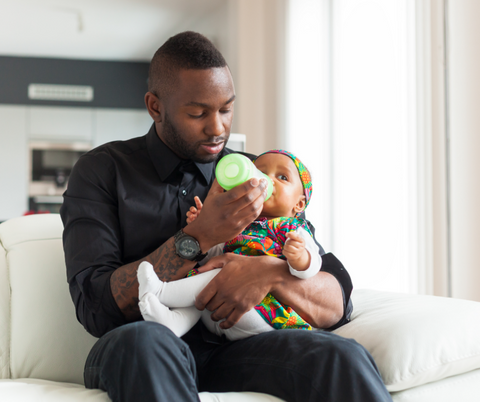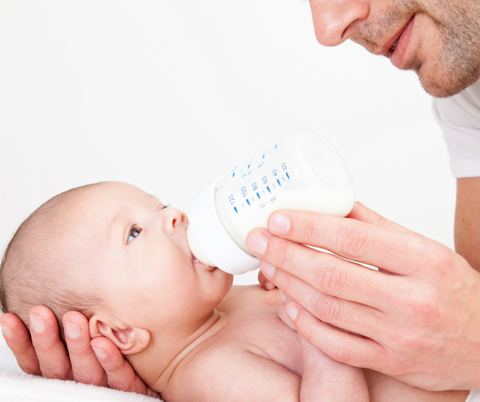BOTTLE-FEEDING FOR NEW DADS
Bottle-feeding your newborn is a surefire way to bond with him or her. If you haven't mastered the art yet, then this six-step guide is a must-read.
There is no right time to 'introduce the bottle'. However, if your baby's mum plans to breastfeed, her lactation consultant would advise her to wait till she has an established breast milk supply and breastfeeding is going well (your baby latches and feeds well). Usually, this is from four to six weeks.
STEP 1: Choose the right bottle
Feeding bottles come in a variety of flow levels, from slow flow to fast flow. Since a mother's breast milk nipple flow is slower than the average bottle nipple flow, you might want to go for slow flow bottle nipples because your baby is already used to a slow nipple flow.
STEP 2: Prepare the bottle
A. Preparing breast milk
Unused breast milk must be kept frozen. But if you have to use it, let it thaw in the fridge or place the bag under warm running water. Make sure it thaws gradually; this will preserve nutrients. Use your clean hands to pour it into a clean bottle and warm it.
B. Preparing formula
You may want to supplement breast milk with some formula. Here's how to make formula for your baby:
- Wash your hands thoroughly.
- Wash the bottle and its parts.
- Read the instructions on the container of the formula for the correct measurements. Be careful not to exceed what has been instructed since too much powder can give your baby an upset tummy.
- Mix the formula either by stirring it gently or shaking the bottle. Either way, make sure you have a smooth formula that doesn't contain lumps that may get stuck in the nipple.
- Warm it.
Pro Tips:
- Baby formula stays fresh for 2 hours at room temperature but 24 hours when refrigerated. Discard any formula that stays longer than that.
- If you opt for shaking your bottle to mix the formula, take off the parts and use a travel cap. These caps are made to seal baby formula for storage or travel.
- There are three ways of warming formula or breast milk. You can use a bottle warmer, which gets the breast milk or formula to the correct body temperature. You can also run the bottle under warm-to-hot water flowing from a faucet. Lastly, you can heat up some water on a stove and put the bottle in it. But let it warm the breast milk or formula and not boil it.
- Turn the bottle every now and then when warming it to prevent hot spots.
- Pour a few drops on the back of your hand to check if the temperature is right for your baby.

STEP 3: Feed your baby
You can feed your baby using these two feeding techniques or positions; cradle hold and paced feeding.
A. Cradle Hold
The cradle hold, also known as the football hold, is a traditional feeding position. Its advantages are preventing ear infection and allowing you to see your baby's face so you can observe the cues they give. It also makes eye contact easy (which helps you to bond better with your baby). To feed your baby using this position:
- Put your baby's head in the crook of your arm.
- Let your hand fit around his or her bottom.
- Lift your elbow so that your baby's head is above the rest of his or her body. Your arm can get crampy after a while, so switch to your other arm when this happens.
B. Paced Feeding
This technique or position allows for slow feeding, which is healthy for your baby. Here's how paced feeding works:
- Let your baby sit up.
- Tickle their lips with the feeding bottle.
- When your baby starts rooting, put the bottle in his or her mouth. Then hold the bottle in a horizontal position.
- Turn the nipple towards the top of your baby's mouth every 20 to 30 seconds to stop the milk or formula from flowing.
STEP 4: Get your baby's latch right
The trying part of bottle-feeding for most first-time dads is getting a good latch. Latching is important. If your baby latches well, it means they are getting enough formula or breast milk. Basically, a good latch is when your baby's tongue is below the nipple, and their lips are locked around the base of the nipple and not the nipple tip. Every baby is different; some have wider latches while others have narrow ones. Try your baby on different bottles to find the best fit.
Pro Tip:
Dip the nipple in breast milk or formula and tickle their lips to get them to latch on.

STEP 5: Bond with your baby
Feeding time is bonding time. While bottle-feeding your baby, make eye contact, sing to them, make faces or smile at them. This helps you to connect deeper with him or her. Level up your bonding; go topless, you and your baby and make skin-to-skin contact.
STEP 6: Burp your baby
In the first few weeks, your baby's digestive system is still developing, and they may get gassy when they swallow air during feeding. Sometimes, they get cranky or spit-up. Burp your baby after every round of 2 to 3 ounces of breast milk or formula. It helps to get rid of the air.
A common burping technique is the over-the-shoulder. To do this:
- Put your baby over your shoulder.
- Pat or rub his or her back to get rid of the air.
Pro Tip:
You can heave your baby up a bit, so his or her belly rests on your shoulder. That way, you can apply a little pressure on their tummies, which also helps.

With this bottle-feeding guide, you are on your way to happy bottle-feeding days!
We would like to hear from you on how this guide has helped. Please share your experiences in the comments section.
By Nana Ama Afoa Osae I Writer I GreatWonderful Team
Leave a comment and share this post on social media.
Follow Us On Twitter, Facebook, Pinterest and Instagram @grtwonderful

Laissez un commentaire
Veuillez noter que les commentaires doivent être approuvés avant d'être affichés